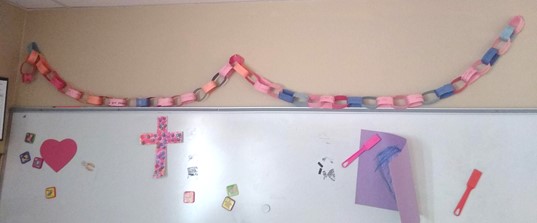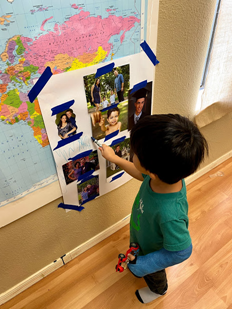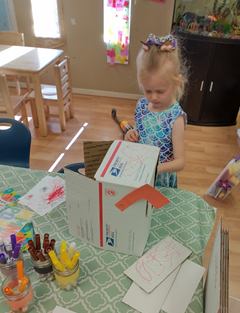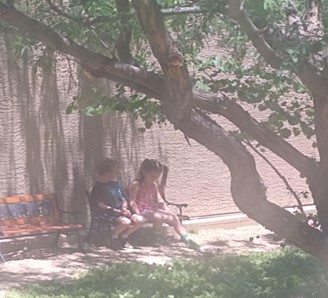A Global Literature Study of Identity and Kindness in Pre-Kindergarten and Preschool Classrooms
Kelsey Nowacki and Jessica Berry
We were first year teachers at Creation School in 2020-2021. Kelsey’s background is in the veterinary field and she decided to make a career change to better accommodate her son’s education and schedule. Jessica majored in elementary and special education. She worked as a substitute teacher and as a special education teacher before staying home for a few years to focus on the care of her young children.
Kelsey’s prekindergarten class of 13 students included eight girls and five boys, ages 4-5. The students were predominantly White, with two Latinx students who spoke English and Spanish at home. One child was of Arabic descent and one of Hawaiian descent. Jessica’s preschool class of nine students was made up of five girls and four boys, ages 3-4. These students were predominately White, with one Latinx student who spoke both Spanish and English at home. All homes were two parent middle- to upper-class families.
In our classrooms at Creation School, we use a mix of Montessori, Waldorf, and Reggio Emilia learning to pursue authentic relationships among teachers and students. We believe that this is the key to developing children’s agency and sense of wonder, inquiry, and responsibility, along with a deep rich understanding of what it means to be children of God.
We were members of our Vail Global Literacy Community and met monthly to study global literature, explore ways to expand students’ knowledge of the world, and learn about developing students’ intercultural understandings. We read articles and Reading to Make a Difference: Using Literature to Help Students Speak Freely, Think Deeply, and Take Action by Lester L. Laminack and Katie Kelly (2019). Through the readings and discussions, we learned that books can be used as a bridge to expand students’ current understandings. Laminack and Kelly (2019) state, “As a bridge, the book enables a reader to span the divide between his current thoughts, views, beliefs, or attitudes and new ideas or insights that may lead to critical thought and new ways of thinking about and living in the world” (p. xiii). They discuss using global literature to develop and expand students’ understandings of life experiences such as loss, making friends, immigration and refugees, helping others, and being kind.
The chapter “Sharing When You Have Little to Give” particularly struck us, pointing out that helping others is often thought of as tangible things, such as donations, medicine, or money; however, helping with our time, energy, attitudes, behaviors, and talents also makes a difference. “Giving is not measured by the pound, in numbers, or in dollars; rather, it is measured by the generosity of spirit and by the care and empathy behind the gift” (Laminack & Kelly, 2019, p. 99). This inspired our conversations about kindness and what our classes could do to help and love others.
The concept of kindness fit with our previous discussions of identity after reading an article by Kathy Short (2009) and the first chapter in Laminack and Kelly’s (2019) book, because we see showing kindness and love as part of identity. Children can deepen insights about themselves while also developing a sense of empathy for others through read-alouds and conversations. “We believe this topic [identity] demonstrates for children how each of us brings a mix of genetics, experiences, thoughts, feelings, attitudes, understandings, biases, beliefs, and family/cultural traditions to the classroom community” (Laminack & Kelly, 2019, p. 2). In this vignette we share how we explored identity and kindness in our classrooms.
Our Studies of Identity and Kindness
Kelsey’s Prekindergarten Classroom
Early in the school year in Kelsey’s prekindergarten classroom, students drew self-portraits and identified the traits they thought God gave them to make them unique. We discussed that while each student had unique differences and similarities, we are all children of God. This became the basis of our identity theme.
We read Chrysanthemum by Kevin Henkes (1991), the story of a young mouse who loves her name, Chrysanthemum, until she starts school and the others tease her. In the end she discovers that her name is her own, relates to her identity, and loves it again. During our second reading the students helped make a timeline graph noting Chrysanthemum’s feelings during the story, sharing how they identified with Chrysanthemum and her feelings, and what they would do in the story. Josephine, age 4, stated, “We should love everybody.”
Along with other teachers in our school, we asked parents for the story behind their child’s name and any connections to their cultural backgrounds. Students were excited to share about themselves at circle time. “My name means Princess!” Abigail, age 5, said. They put a star sticker on a world map of the countries from which their families originally came. We then reiterated that Jesus loves all the children of the world and wants us to do the same. Lacey Elisea, Jane Metzger, and Cassandra Sutherland also discuss learning about students’ names and plotting their families’ origins on a world map in their article in this issue.
Toward the end of the year students drew another self-portrait, this time “inside out.” Laminack and Kelly (2019) state, “Though they know each other rather well, these posters reveal some inward feelings and thoughts they may not have shared prior to this exploration. In addition, there may be a disconnect between how one views oneself and how one is viewed by others” (p. 15). To adapt this, we asked the prekindergarten students to identify what was inside their hearts and minds. We discussed how someone looking at them cannot “see” into their heart and only knows what is in their heart and who they are by how they act. Students’ suggestions for how to show the kindness in their hearts included, “Get a teacher when [someone] fall[s]” (Maddox, age 5); “Help mommy clean up” (Kiera, age 5), and “Not take toys” (Oriana, age 5). We brought the discussion back to how we should be loving to others.
Examples of students’ “inside out” drawings are in Figures 1 and 2. Figure 1 shows Oriana’s, age 5, drawing of herself. For inside her heart she said, “I love God. I really super duper 100% love Him. I love myself.” For outside she said, “I like swinging. I’m playful. Love the outdoors.”
Abigail’s, age 5, drawing is in Figure 2. She explained that the inside of her heart shows she is kind and brave while on the outside she is playful and a sister.
To highlight kindness and discuss how it relates to identity, we read Never Too Little to Love by Jeanne Willis and Jan Fearnley (2013), Berenstain Bears Think of Those in Need by Stan and Jan Berenstain (1999), and When I’m Feeling Kind by Trace Moroney (2015). We discussed how these books show that one small act of kindness can change someone’s entire day. To help illustrate how small acts can make a big change we started a kindness chain. Every time students were seen doing something kind at school, we made a loop on the chain. Examples of the kindness loops included picking a flower for mommy, giving a toy to a friend, getting an ice pack for a friend who fell, and asking if someone was ok if they looked sad. Once the chain was large enough, we hung it up in the class for all to see. The students said that they wanted to make the chain go all the way to the corner of the wall. They surpassed their goal (see Figure 3)!
Jessica’s Preschool Classroom
In Jessica’s preschool classroom, Jessica invited students to bring in several pictures of their families as a way to think about identity. We placed each student’s pictures on butcher paper and had the students draw their families and how they felt about their families while discussing the different family members. Brandon happily drew circles because his dog “runs in circles when he is happy.” Family pictures from Nick, age 3, are in Figure 4.
Students had different family structures: one had half-siblings, some had adult siblings, some had younger siblings, and one even had an au pair. Students found it fun to discuss the differences and similarities, “You have a little brother, just like me!” Georgia commented.
To focus on kindness, we first read It Came in The Mail by Ben Clanton (2016). In this book a little boy waits for mail. When mail starts coming through his mailbox, he has too much. In the end, he sends mail so other children can feel the joy of receiving it. We discussed the excitement of receiving good news through the mail and each student made postcards for teachers and fellow students around the school. They also made a mailbox for our class to receive mail. Figure 5 shows Jaclyn, age 4, working on the mailbox. The students were excited to receive notes in the mailbox, including some from Kelsey’s prekindergarten class.
We continued our conversation of spreading kindness by reading When I’m Feeling Kind by Trace Moroney (2015) (see Figure 6). This story follows a bunny and all the things the bunny does for family members and friends to be kind. The book sparked the students’ brainstorming of ways they can be kind and helpful. These included “Give my friend a hug when she is feeling sad,” and “Help my mom with my little brother.”
Finally, we read Be Kind (Miller & Hill, 2018). This book tells of a little girl who witnesses something embarrassing happen to a friend and all the things she could think of to do to be kind to her friend, leading up to giving her friend a picture. While reading this book, the students empathized not only with the character doing the act of kindness, but also the character who experienced embarrassment. This spurred a later conversation discussing the ways we feel sad and the ways we would like to have kindness shown to us.
We also discussed ways to show kindness on the playground. Students’ responses included “Run with my friends” and “Play with my friends.” When asked, “How would you know if a friend doesn’t have someone to play with on the playground?” they were unsure how to respond. That is when we introduced buddy benches, an idea we got from Laminack and Kelly (2019). A buddy bench is a place on the playground for students to sit when they are lonely and need a friend with whom to play, so that “other kids can see them and be friends with them” (Laminack & Kelly 2019, p. 126). We already had benches that a parent built for us to use on the playground and “re-purposed” them with all of the classes, not just our own, into buddy benches (see Figure 7). When someone was feeling lonely or upset, they sat on the bench and a classmate would see and check on them.
Buddy benches were a huge success with all the classes. Students who do not normally interact with each other began sitting, talking, and/or playing together. For example, we saw prekindergarten students sitting with early learners (2-3 years old). It became schoolwide evidence of kindness and empathy. We asked our students how they felt knowing they were able to help someone. “It feels good,” said Colton, age 5. We discussed how it makes them feel good to help others feel good.
Reflection
Laminack and Kelly (2019) stated in their introduction that, “Some texts affirm our lives based on similarities and connections, while others provide us a window into the unfamiliar” (p. xvii). For preschool/prekindergarten students, a lot about school is unfamiliar and we introduce them to many concepts, sometimes for the first time. Through these experiences, each student knew what it meant to be kind, had language to verbalize their ideas, and the background to build on further in considering acts of kindness.
Students at Creation School taught us a lot, taking on kindness challenges as they were also learning to know themselves. It was joyful to see them run to help a friend up, sit on the buddy bench with someone, or to see their smile when another loop on the kindness chain was added. Our goal is that students continue to explore their identity and always find ways to be kind. Being able to use books to demonstrate these strong values is critical. Not only is it helping students learn to read but to become empathetic caring beings.
References
Laminack, L., & Kelly, K. (2019). Reading to make a difference: Using literature to help students speak freely, think deeply, and take action. Portsmouth, NH: Heinemann
Short, K. (2009). Critically reading the word and the world: Building intercultural understanding through literature. Bookbird: A Journal of International Children’s Literature, 47(2), 1-10.
Literature Cited
Berenstain, S., & Berenstain, J. (1999). Berenstain Bears think of those in need. New York: Random House.
Clanton, B. (2016). It came in the mail. New York: Simon & Schuster.
Henkes, K. (1991). Chrysanthemum. New York: Greenwillow Books
Miller, P.Z., & Hill, J. (2018). Be kind. New York: Roaring Brook.
Moroney, T. (2015). When I’m feeling kind. Scoresby, Australia: Five Mile.
Willis, J., & Fearnley, J. (2013). Never too little to love. Somerville, MA: Candlewick.
Kelsey Nowacki has a background in the veterinary field and was a first-year teacher at Creation School.
Jessica Berry’s background is in elementary and special education and was a first-year teacher at Creation School.
© 2021 by Kelsey Nowacki and Jessica Berry
WOW Stories, Volume IX, Issue 2 by Worlds of Words is licensed under a Creative Commons Attribution-NonCommercial-ShareAlike 4.0 International License.
Based on a work by Kelsey Nowacki and Jessica Berry at https://wowlit.org/on-line-publications/stories/volume-ix-issue-2/7/.
WOW stories: connections from the classroom
ISSN 2577-0551







